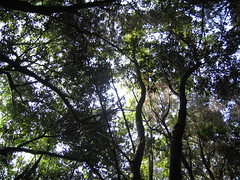
Garajonay National Park (Spanish: Parque nacional de Garajonay) is located in the center and north of the island of La Gomera, one of the Canary Islands. It was declared a national park in 1981 and a World Heritage Site by UNESCO in 1986. It occupies 15 square miles (40 square km) and it extends into each of the municipalities on the island.
The park is named after the rock formation of Garajonay, the highest point on the island at 1,484 meters (4,869 feet). It also includes a small plateau whose altitude is 2,600-4,600 feet (790-1,400 m) above sea level.
The park provides the best example of laurisilva, a humid subtropical forest that in the Tertiary covered almost all of Europe. It is also found on the Azores and the Madeira Islands. Laurus azorica, known as Azores Laurel, or by the Portuguese names Louro, Loureiro, Louro-da-terra, and Louro-de-cheiro, can be found in the park, as well as Laurus canariensis, known as Canary Laurel.
The forests are made up of laurel-leaved evergreen hardwood trees, reaching up to 40 meters in height. Many of the species are endemic to the islands, and harbor a rich biota of understory plants, invertebrates, and birds and bats, including a number of endemic species.
Two species of reptile, Gallotia gomerana (Gomeran lizard) and Chalcides viridanus (Gomeran skink), can be found. Amphibians include the stripeless tree frog, Hyla meridionalis.
The park is renowned as one of the best places to observe the two Canarian endemic pigeons, Laurel Pigeon (Columba junoniae) and Bolle's Pigeon (Columba bollii).
1 comment:
酒店經紀菲梵,酒店經紀~free fun~,酒店經紀,酒店經紀,酒店上班,酒店上班,酒店小姐,酒店小姐,酒店工作,酒店工作,酒店打工,酒店打工,酒店兼差,酒店兼差,酒店兼職,酒店兼職,經紀人,經紀人,禮服店,禮服店,便服店,便服店,
Post a Comment